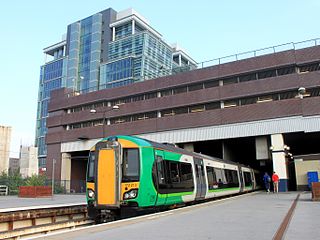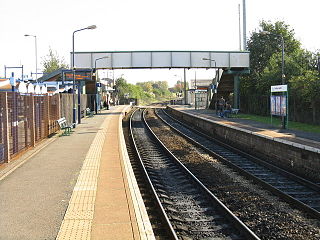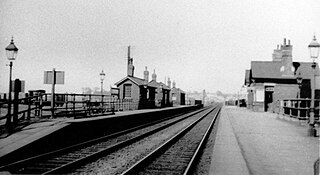
Birmingham Snow Hill, also known as Snow Hill station, is a railway station in Birmingham City Centre. It is one of the three main city-centre stations in Birmingham, along with Birmingham New Street and Birmingham Moor Street.

The West Midlands Metro is a light-rail/tram system in the county of West Midlands, England. The network has 33 stops with a total of 14.9 miles (24.0 km) of track; it currently consists of a single route, Line 1, which operates between the cities of Birmingham and Wolverhampton via the towns of Bilston, West Bromwich and Wednesbury, on a mixture of former railway lines and urban on-street running. The system is owned by the public body Transport for West Midlands, and operated by Midland Metro Limited, a company wholly owned by the West Midlands Combined Authority.

Birmingham is a major transport hub, due in part to its location in central England. The city is well connected by rail, road, and water. Public transport and key highways in the city are overseen by Transport for West Midlands (TfWM).

The Chiltern Main Line is a railway line which links London and Birmingham on a 112-mile (180 km) route via High Wycombe, Bicester, Banbury, Leamington Spa and Solihull in England.

The Cross-City Line is a suburban rail line in the West Midlands region of England. It runs for 32 mi (51 km) from Redditch and Bromsgrove in Worcestershire, its two southern termini, to Lichfield, Staffordshire, its northern terminus, via Birmingham New Street, connecting the suburbs of Birmingham in between. Services are operated by West Midlands Railway.
The Birmingham and Gloucester Railway (B&GR) was the first name of the railway linking the cities in its name and of the company which pioneered and developed it; the line opened in stages in 1840, using a terminus at Camp Hill in Birmingham. It linked with the Bristol and Gloucester Railway in Gloucester, but at first that company's line was broad gauge, and Gloucester was a point of the necessary but inconvenient transhipment of goods and passengers onto 4 ft 8+1⁄2 instandard gauge that became the national standard. Nearly all of the original main line remains active as a "trunk" route, also known as an arterial route or line.

Five Ways railway station is a railway station serving the Five Ways and Lee Bank areas of Birmingham, England. It is situated on the Cross-City Line.

Birmingham Moor Street, also known as Moor Street station, is one of three main railway stations in the city centre of Birmingham, England, along with Birmingham New Street and Birmingham Snow Hill.

Kings Norton railway station serves the Kings Norton and Cotteridge areas of Birmingham, England. It lies on the Cross-City Line from Redditch and Bromsgrove through Birmingham New Street to Lichfield. The station's main entrance is located on Pershore Road South, the A441.

The Birmingham to Worcester via Kidderminster line is a railway line which runs from Birmingham Snow Hill to Worcester via Stourbridge and Kidderminster in the West Midlands, England. It is one of the Snow Hill Lines, with trains operated by West Midlands Trains and Chiltern Railways using a variety of rolling stock including Class 172 and Class 168 diesel units. It is a future aspiration of Network Rail to electrify the entire line, as well as the Chiltern Main Line to London Marylebone.

Bordesley railway station is a small railway station serving the area of Bordesley in Birmingham, England located between Birmingham Moor Street and Small Heath stations. The current minimal level of service at the station is provided by West Midlands Trains services between Whitlocks End and Kidderminster via Birmingham Snow Hill. The station is the least used in the West Midlands county with only 9,088 passengers using it annually.

The Walsall–Wolverhampton line is a railway line in the West Midlands, England. It connects the town of Walsall to the city of Wolverhampton. The complete line does not currently have any regular scheduled passenger services: The line's local passenger service was withdrawn in 1965, it was restored in 1998, only to be withdrawn again in 2008. At present, the main use of the line is by freight trains, and it is also used as a diversionary route when engineering works are carried out on the West Coast Main Line.

Cradley Heath railway station serves the town of Cradley Heath in the West Midlands of England. It is on the Birmingham to Worcester via Kidderminster line. The station is managed by West Midlands Railway, who provide the majority of train services; there are also occasional services provided by Chiltern Railways.

Moseley Village railway station is a railway station under construction in Moseley, Birmingham. It was first opened in 1867 and closed in 1941.

The Snow Hill Lines is the collective name for the railway lines running through Birmingham Snow Hill, and Birmingham Moor Street stations in Birmingham, United Kingdom. They form an important part of the suburban rail network of Birmingham, Warwickshire and Worcestershire. All other lines to/through Birmingham use Birmingham New Street station. The Snow Hill lines carry around 20% of the daily rail services into Birmingham; the remainder use New Street.

Kings Heath railway station is a railway station under construction in Kings Heath, Birmingham. It was originally opened in 1840 before being closed to passengers in 1941.

Lifford railway station refers to a series of railway stations in Cotteridge, Birmingham, England.
The Birmingham West Suburban Railway was a suburban railway built by the Midland Railway company. Opened in stages between 1876 and 1885, it allowed both the opening of development of central southwest suburban Birmingham south into Worcestershire and the by-passing of railway traffic via the Birmingham and Gloucester Railway into central Birmingham. Today, it forms a major section of the Cross-City Line, running from Lichfield to Redditch. It also forms an important part of the Cross Country Route.
The Birmingham and Oxford Junction Railway was an English railway line promoted by the Great Western Railway to gain a route from its southern base towards the industrial centres of the West Midlands, and in due course the north-west. It overtook another GWR subsidiary, the unbuilt Oxford and Rugby Railway, and the Birmingham Extension Railway which was to build a new independent station in the city. It was authorised in 1846 and formed a single project to connect Birmingham and Oxford.
Brighton Road railway station is a former railway station in Balsall Heath, Birmingham. It was originally opened in 1875 before being closed to passengers in 1941.






















